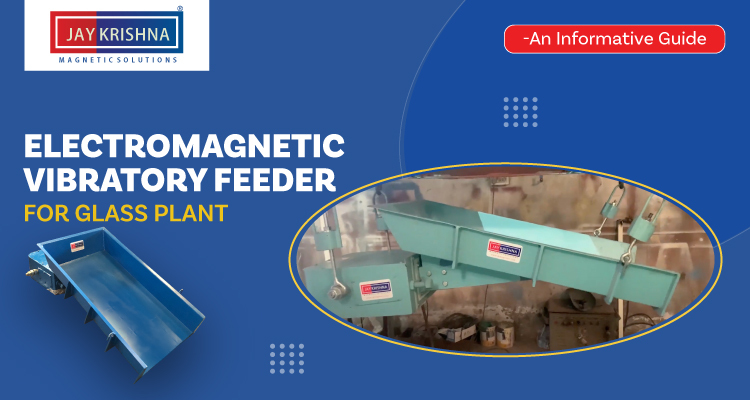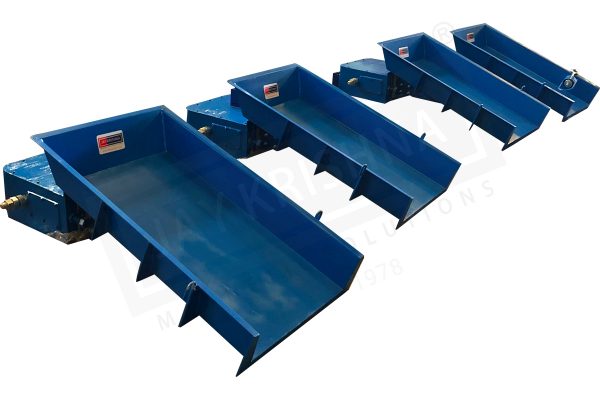Electromagnetic Vibratory Feeder For Glass Plant – An Informative Guide

In every industry where material separation is needed, having precise control over the feed rate of bulk materials is necessary.
And that is what an Electromagnetic vibratory feeder does, provides precise control over bulk material flow rate and ensures the product quality meets the client’s expectations.
The electromagnetic vibratory feeder working principle is an example of Newton’s first law. A vibratory feeder is a device that uses vibration to feed material through a process while also controlling the flow rate.
Both vibration and gravity are used in the process to move material forward. With the gravity force, the machine parts get in the movement, simultaneously, vibration force trigger’s the material movement.
Jaykrishna Magnetics is a leading manufacturer of vibratory feeders, developing various kinds of vibratory feeders and equipment for diverse applications in all kinds of industries, ranging from glass to the food industry, pharmaceuticals to many more.
We developed different types of vibratory feeders with the use of advanced technology. This technological advancement and the latest design of Electromagnetic vibratory feeder make it an ideal choice for industries where greater product purity, energy cost savings, decreased equipment maintenance expense, and streamlined manufacturing operations are expected.
But how does it work? Is Electromagnetic Vibratory Feeder an ideal solution for desired industrial requirements? And so on. These question arises when you finally decide to make your separation process more productive with a vibratory feeder.
No more unanswered questions!
Browse through this blog and find answers to all your questions.
What is Electromagnetic Vibratory Feeder?
A type of vibratory feeder, an electromagnetic vibratory feeder, is a device used for handling bulk materials.
The device is a converting system developed to feed components or materials into an accumulation process using controlled gravity and vibratory force mechanism to reduce the risk of material clogging. The low-maintenance electromagnetic vibratory feeder includes various process equipment such as belt conveyors, screening machines, crushers, dryers, and more; that precisely help regulate feed rates of dry bulk materials.
The low-maintenance electromagnetic vibratory feeder includes various process equipment such as belt conveyors, screening machines, crushers, dryers, and more; that precisely help regulate feed rates of dry bulk materials.
The primary function of a vibratory feeder involves conveying bulk materials, specifically fine powders, bulk solids, and highly abrasive materials.
How does Electromagnetic Vibratory Feeder work?
An electromagnetic vibratory feeder works on the mechanical phenomenon of vibration to control the flow rate. Whether the material is small or large in size, the vibratory feeder works on the same principle and moves the product by vibrating the feeder.
The process moves further through a combination of two forces, vibration, and gravity. The force of gravity determines the direction of the part’s flow, causing the flow to either move horizontally or vertically.
The force of vibration in the drive unit is used to move the materials. The vibration force results in the constant movement of material on the feeder.
A vibratory feeder is made up of various parts that contribute to material separation. The following parts are the drive unit, trough, feed end, discharge end, and eccentric weight.
- Reactor springs for storing and releasing energy,
- Isolation springs for protecting the structure during vibrations,
- Turning spring for tuning the frequency,
- Dynamic balancer for reducing the transmitted dynamic forces.
Due to this effective separation process, vibratory feeders are part of numerous industries for easy and fast separation of bulk materials with proper flow control.
In which industries Electromagnetic Vibratory Feeders are used?
Applications of Electromagnetic Vibratory Feeder
-
Glass Industries –
Electromagnetic Vibratory Feeder for glass plant is used for handling glass cullet to the furnace and glass products. Also, it works well for handling chemical additives like ash, soda, etc.
-
Chemical Plants –
A Vibratory feeder for the chemical plant is used for controlling ingredients flow to mixing tanks.
-
Pulp And Paper Industries –
A Vibratory feeder for the pulp and paper industry is used for feeding chemical additives in batch processing.
-
Iron and Steel Industries –
A Vibratory feeder for the iron and steel industry is used for controlling the flow of iron ore, scrap, and smelting furnace.
-
Foundries
A Vibratory feeder for the foundry industry is used for the addition of binders and sand processing systems.
-
Ceramic Industries
A Vibratory feeder for the ceramic industry is used for controlling the ingredients in batch processing.
Features And Technical Specifications Of Vibratory Feeders
Features of Electromagnetic Vibratory Feeder:
- Robust Construction
- Low Noise
- Low production cost
- Consistent material flow
- Assured product purity
- Low maintenance cost
- Design flexibility for diverse application
- Safety under the hazardous conditions
Technical Specification of Electromagnetic Vibratory Feeder:
- Tray made of Mild Steel or Stainless Steel
- Body housing made of Heavy-duty M.S Plates
- Strong magnets for producing vibration
- Practical controller for controlled material flow
- Enclosed design for a dustproof device
Factors to consider when buying an Electromagnetic Vibratory Feeder
-
Energy Efficient
Installing a vibratory feeder is a worthwhile investment hence, it is important to make sure that the device is energy efficient. One should definitely consider how much energy is required to perform the separation task.
-
Separation Speed
The second factor is to check how quickly the product will be sorted and what time it will need to convey on the vibratory feeder to maintain the required materials flow.
-
Tray Design
The tray design has no customization limit. It comes in various sizes, shapes, and designs. Depending on your production line, you will need to decide what is the right fit.
Also, the units can be furnished with special coatings as per the needs. Suppose you require moving heavier duty materials, then; you can opt for stainless steel furnishing.
On the other hand, if you require something for moving liquid material or any other kind of material where the leakage is a concern, then you can consider neoprene, urethane, or other removable coatings.
-
Feed Rate
Feed rate is the velocity at which the feeder is fed. Expressed in units of distance per revolution for turning, the feed rate is part of your machine required for running effectively. The higher the feed rate, the higher the outcome.
Ultimately
Vibratory feeders are a revolutionary solution for your industrial separation needs.
Jaykrishna Magnetics Pvt. Ltd. is a leading vibratory feeder manufacturer, designing precise vibratory equipment considering all essential factors like material size, material texture, feed rate, load volume, vibration amplitude, and intensity.
Developed according to industrial standards, our precisely engineered vibratory feeders provide accurate separation and meet the exact requirements and specifications of diverse applications.
To know more about our product range visit our website: www.jkmagnetic.com
If you are looking for Electromagnetic Vibratory Feeder, then feel free to contact us. We can provide you with customized Electromagnetic Vibratory Feeder to meet your industrial needs and requirements.
We will guide you with our best help to provide you with the fastest solution to your separation problems.
- How do Electromagnetic Vibratory Feeders Work? – Components & Principles
- Magnetic Separator & Vibratory Feeder For Waste Rubber Tire Recycling- An Informative Guide
- Eddy Current Separator & Vibratory Feeder Installed In Pet Recycling Plant
- Industrial Vibratory Motors – The Definitive Guide
- How To Separate Aluminium From Wood Chips – Eddy Current Separator

